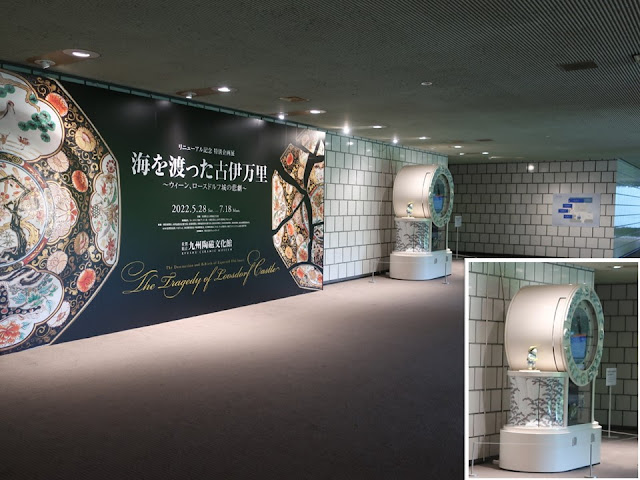The huge museum is in Arita Town of Kyushu Island, which is one of the four main islands of Japan. We can see abundant ceramics for free (I visited in 2022). Arita is famous for the production of ceramics.
During the invasion to Korea (1592-1598), the warlords took Korean potters to their
territories in Japan. It caused ceramic production; the story is written in the
history textbooks for middle school students. It was a really shameful act.
Korean potters who could use a wheel initiated Arita ware. I’d like you to see
the wonderful exhibits at the official website (https://saga-museum.jp/ceramic_en/), and I’ll show how people have enjoyed owning and using the classy ceramics
in my blog.
陶磁器の生産地・有田にある巨大な博物館です。豊富な展示品を無料で拝見できます(2022年訪問)。
豊臣秀吉による文禄・慶長の役(1592-1598)に加わった九州や山口の大名が、朝鮮の陶工を連れ帰り、陶磁器生産が興ったといいます。教科書にも書かれている話ですが、ひどいことです。有田にもロクロの技術を持つ陶工たちが来て、有田焼が始まりました。素晴らしい作品の数々は、ウエブサイト(https://saga-museum.jp/ceramic/ )をご覧いただくとして、陶磁器を持つ楽しみを紹介していきます。
There is a big and grand clock at the entrance hall.
エントランスには陶器の時計。ゴージャスですね。
Many ceramics are used in the restroom. I hesitated to use it.
おトイレにも陶器が。汚すのは気が引けますね。
The royalty and nobility in Europe decorated castles with porcelain. However, after China rescinded the prohibition of trade in 1684, Arita ware lost overseas market and turned to the domestic market; a rising standard of living in Japan made growth in demand for porcelain back then. It says, "Creative steps such as trimming production costs and having kilns specialize in certain types of products allowed the industry to manufacture goods in response to demand, ranging from premium to inexpensive products". It's so similar to the current situation.
シャンデリアなど欧州の王侯貴族が磁器を買い求めました。しかし、1684年に中国の貿易禁止が解かれると(展海令)、ヨーロッパ市場を中国製品が占め、有田焼は、「生活水準の向上によって磁器の需要が拡大する国内市場に向け、生産コストの縮減や窯場による製品の作り分け等の工夫を行い、高級品から安価なものまで需要に応じて生産していきました」、と書かれています。いまいまの話みたいですね。
The section “Edo Style” shows various scenes in which porcelain were used in the late Edo period (1603~1868). It is written, “The Japanese cultural trait of using porcelain, which continues today, tells a tale that first took shape during this period.” Using classy things make us happy!
「江戸の粋」というテーマで、江戸時代後半から暮らしのなかに浸透してきた有田焼の磁器を紹介しています。食事に限らず、さまざまなシーンで使われるようになり、磁器を使う日本文化が形成されたと書かれています。良い品を使っていると、幸せな気分になれますね。
Things for calligraphy: from the left, brush stand, desk screen, brush stem, ink stone and water pitcher. The porcelain stem and the ink stone are so rare.
書道の道具は、陶器になると全く雰囲気が変わりますね。
Models of an Edo-period Banquet: Large plates and bowls of food were served.
江戸時代の宴席の再現:料理を持った大皿などが宴席に出されています。
Formal style of dining (honzen) in the Edo period、江戸時代の本膳料理の膳組
Arita Town、有田の町
I went to a shopping mall “Arita Será” to buy tableware. There is a shrine at the end of the street.
ショッピングモールのアリタセラに食器を買いに行きました。通りの奥にはしめ縄が張られています。
There is a portable shrine which roof is made from ceramic rice bowls. The god of ceramics which is enshrined at Sueyama Shrine also resides here. In Arita rice bowl festival, a memorial service is held for broken or used ceramics such as a rice bowl. It’s very Japanese style.
茶わん神輿は、焼き物の神様「陶山神社」の分霊を勧請し、「有田のちゃわん祭り」にて、焼き物への感謝を込めて茶碗の供養を行います。日本人らしいですね。
In Sueyama Shrine, ceramic lanterns are dedicated. The torii-gate is also made of ceramics.
陶山神社には、陶磁器の灯籠が奉納されています。そして、鳥居も陶磁器です。
Sueyama Shrine is close to Uchiyama Street which is designated as “Preservation Districts for Groups of Traditional Buildings” by the government. It is called “Arita Senken (a thousand shops)”; ceramic stores stand side by side.
陶山神社は、重要伝統的建造物群保存地区に指定されている有田内山の通りから少し入ったところにあります。有田千軒と呼ばれ、陶磁器屋が軒を連ねる通りです。
Visited in
May, 2022
Official
website: https://saga-museum.jp/ceramic_en/
https://saga-museum.jp/ceramic/ (in Japanese),
accessed in November, 2022
Previous
post (ruins in the ancient time): Yoshinogari
Historical Park、吉野ヶ里歴史公園
Next post (museum in the neighboring prefecture): Nagasaki Museum of History and Culture、長崎歴史文化博物館













Comments
Post a Comment